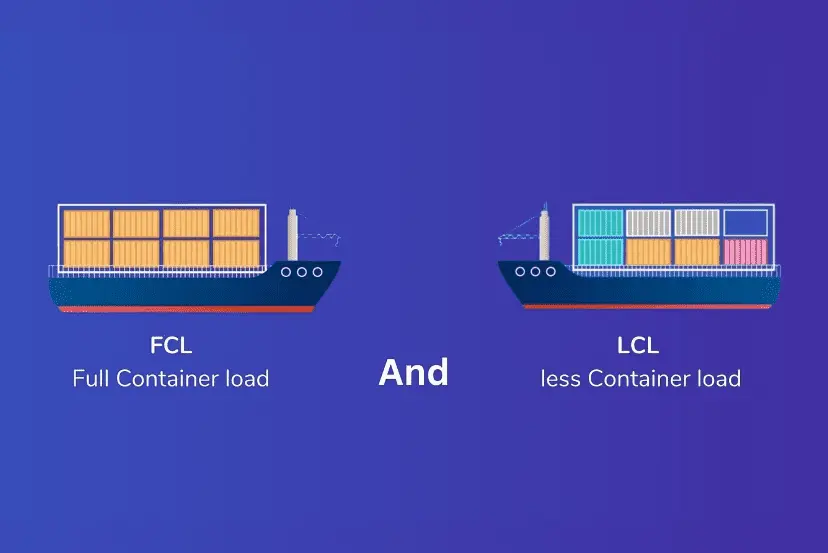- By TOP CHINA FREIGHT
- August 13, 2025
- Shipping
International shipping is a complex process, and selecting the correct method—FCL vs LCL—can have a significant impact on cost, speed, and cargo safety. This guide provides in-depth insights into each shipping method, with around 30% of content focusing on transportation logistics and practical tips.

1.Understanding FCL and LCL
FCL (Full Container Load):
FCL means the shipper rents an entire container exclusively. This is ideal for large shipments or valuable cargo. Key points:
- Reduced handling and lower risk of damage
- Faster transit since it often travels directly from port to port
- Cost-effective per unit for bulk cargo
LCL (Less than Container Load):
LCL allows multiple shippers to share a container. It’s suitable for smaller shipments:
- Flexible and accessible for small businesses
- Cost is based on volume (cubic meters)
- Longer transit times due to consolidation
| Feature | FCL | LCL |
|---|---|---|
| Container Use | Exclusive | Shared |
| Cargo Handling | Minimal | Multiple handlings |
| Cost | Fixed per container | Volume-based, may include extra fees |
| Transit Time | Faster | Slower |
| Risk | Lower | Higher (more touchpoints) |
| Best For | Large shipments | Small or irregular shipments |
2.Detailed Cost Comparison
Shipping costs depend on several factors: container type, cargo volume, port charges, and additional handling.
FCL Costs:
- Charged per container (20ft, 40ft, 40HC)
- Economical for large shipments
- Lower per-unit cost due to full container usage
LCL Costs:
- Priced per cubic meter (CBM) or weight
- Includes consolidation, deconsolidation, terminal handling fees
- Higher per-unit cost but lower upfront cost
Transportation Insight:
For shipments exceeding 10–15 CBM, FCL is often cheaper per unit, while LCL works best for smaller consignments that do not justify paying for a full container.
3.Transit Times and Logistics
FCL:
- Direct routes reduce transit time
- Less handling means fewer delays
- Average transit from Shanghai to Los Angeles: 15–20 days
LCL:
- Consolidation may add 3–7 days before departure
- Multiple handling points increase risk of delays or damage
- Transit from Shanghai to Los Angeles: 18–25 days on average
Transportation Tip:
When shipping perishable or high-value items, FCL reduces transit-related risks. For small, non-urgent shipments, LCL provides cost flexibility but requires careful scheduling.
4.Step-by-Step Shipping Process
- Book container with a freight forwarder
- Prepare and pack cargo for a full container
- Transport cargo to the port
- Load cargo exclusively into the container
- Container shipped directly to destination port
- Customs clearance and delivery
- Book LCL shipment specifying cargo volume
- Prepare and pack cargo according to consolidation standards
- Transport cargo to consolidation warehouse
- Cargo consolidated with other shipments into one container
- Container shipped to destination port
- Cargo deconsolidated, cleared by customs, and delivered
5.Container Types and Their Role in FCL vs LCL
| Container Type | Description | CBM (Cubic Meters) | Best For |
|---|---|---|---|
| 20ft Standard (FCL) | Standard 20ft container | 33 CBM | Smaller bulk shipments |
| 40ft Standard (FCL) | Standard 40ft container | 67 CBM | Medium to large shipments |
| 40ft High Cube (FCL) | Extra height container | 76 CBM | Oversized cargo |
| Shared 20ft/40ft (LCL) | Multiple shipments consolidated | Allocated based on CBM | Small shipments sharing container space |
Transportation Tip: Choosing the correct container type improves space utilization and reduces shipping costs.
6.Packing and Cargo Safety
| Shipping Method | Packing Tips | Notes |
|---|---|---|
| FCL | Use pallets for heavy items | Maximize container space to reduce per-unit cost |
| FCL | Secure cargo to avoid shifting | Reduces damage risk during transit |
| LCL | Label packages clearly | Ensures easy identification in consolidated containers |
| LCL | Avoid fragile/high-value items unless insured | Multiple handling increases risk |
| LCL | Use standard pallet sizes | Facilitates easier consolidation and loading |
Transportation Insight: Proper packing minimizes damage risk, especially in LCL shipments with multiple handlings.
7.Advantages of FCL vs LCL
| Shipping Method | Advantages |
|---|---|
| FCL | – Exclusive container use reduces risk – Faster transit with direct port-to-port shipping – Lower per-unit cost for bulk shipments – Better security for high-value or fragile goods – Fewer customs and handling points reduce risk |
| LCL | – Cost-effective for small shipments – Flexible for varying cargo volumes – Accessible for startups and low-volume exporters – Lower upfront shipping expenses – Ideal for non-urgent shipments |
8.Factors to Consider
- Shipment size and volume
- Transit time requirements
- Cargo type and sensitivity
- Budget and cost per unit
- Port handling and consolidation time
Conclusion
Choosing between FCL vs LCL depends on shipment size, urgency, budget, and cargo sensitivity. FCL is best for large, time-sensitive shipments, while LCL is cost-effective for small, flexible consignments. Proper planning, packing, and coordination with freight forwarders ensure smooth shipping and optimal transportation outcomes.
Need a Shipping Quote?
If you want expert guidance and peace of mind, our team is ready to assist.
TJ China Freight offers tailored solutions to help businesses of all sizes ship more reliably from China.
FAQs
Q1:Can I upgrade from LCL to FCL if my shipment grows?
Yes, full container booking is possible if volume increases.
Q2:Is cargo insurance necessary for LCL?
Strongly recommended due to multiple handling points.
Q3:Which is safer for fragile items?
FCL offers safer transit with fewer touchpoints.
Q4: Are transit times predictable?
FCL transit times are more predictable; LCL may vary due to consolidation.
Q5:How do costs compare for small shipments?
LCL is cheaper upfront for small shipments but may be more expensive per unit.
